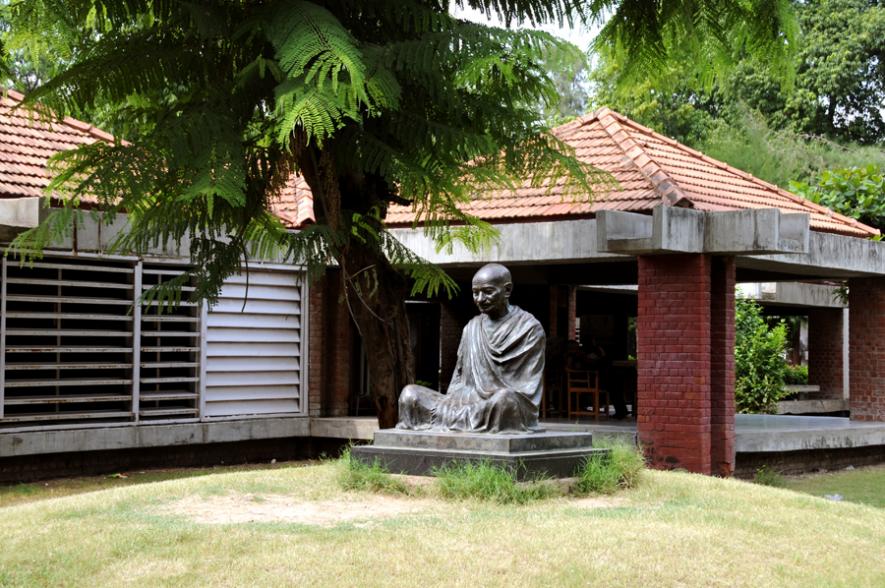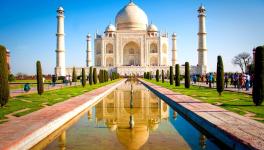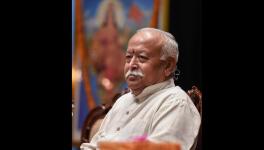Killing Gandhi Again: How a Spartan Leader’s Essence is Being Belittled by Glam Projects

Sabarmati Ashram, Ahmedabad
'Whenever you see colour, think of us', the paint company Jenson and Nicholson ran its advertisement campaign with this tagline for years. It marketed the idea of synonymity of the company with colour, the main characteristic of its products.
Likewise, whenever one thinks of Mahatma Gandhi, the central idea that crosses the mind is that of non-violence, disobedience, peace and austerity, either of the notions by itself, in a combination of ones or twos, or all collectively.
Gandhi is not a God who cannot be critiqued. And, there have been many from his lifetime who disagreed with his choice of peaceful means, his strategy to weaponise self-denial, to fight a brutal colonial regime.
One can contest Gandhi's introduction of personal religiosity into public life and political vocabulary, especially in a multi-faith country with its history of religion-based conflict. The list of disagreements with his political strategies and socio-political viewpoint can be long and deep.
But, at no point can one question his choice of simplicity in personal life. Anyone who makes the image of Gandhi and his legacy less austere and jazzes up his memory, hits at the core of Gandhianism.
The sanctity of Gandhian austerity faces a threat in the Rs 1,246 crore Sabarmati Ashram makeover project, now being pursued with the intention of converting the spartan memorial into a "world class" monument that will draw tourists in greater numbers.
This un-Gandhian pursuit marks another major step in the commodification of Gandhi, underway for decades, even in his lifetime. What, however, makes this project different is the political blessings it has, and for being part of a politics of appropriation and makeovers of this regime.
It is greatly worrisome, as it comes close on the heels of the Jalianwala Bagh makeover where the monument's previous grimness has been compromised at the altar of the desire to make it tourist-friendly and visually appealing. In addition, this regime's predilection for grandeur and opulence is well known and visible in every action from the riverfront drives in Ahmedabad and Varanasi to the Sardar Patel statue, a project pursued with the intentions of entering record books and creating a 'wow' factor.
Because details of how the firm (same one contacted for the riverfront project in Ahmedabad and Central Vista) intends refurbishing the Sabarmati Ashram are not available, worries will persist if Bollywood-like murals will adorn the space known for its simplicity, just as they leap out of the once grim alleyway leading into the Jalianwala Bagh.
The Essence of Gandhi
There are two sites that exemplify the essence of Gandhi, the life he lived, and the way he died. The Sabarmati Ashram in Ahmedabad is the place where Gandhi lived for more than a decade during the formative years of the nationalist sentiment becoming a mass movement. It was from this site that Gandhi embarked on the Dandi March, that besides igniting people and becoming the launch pad of the Civil Disobedience movement, also secured global notice for the anti-colonial struggle of the Indian people.
The second site is the Gandhi Smriti in New Delhi, where he lived his last days and where he was assassinated. While the Sabarmati Ashram, where Gandhi never returned after his departure for Dandi, is the place where the Gandhian moral compass of the national movement was set, the house in Lutyens' Delhi is the place that serves a reminder to the extent of hatred he aroused by his inclusive pursuits.
The sacrosanctity of these two memorials needs to be retained if Gandhi has to be understood by coming generations.
Although he personally advocated a pre-modern lifestyle to identify with the majority of Indians of the time, Gandhi did not shun tools of modernity if they advanced his political pursuits. The Dandi March was steeped in ancient religious and moral principles, but he readily made himself available to journalists who flocked from different places of the world and transmitted his words using modern technology. Gandhi spun the charkha, but allowed the modern camera to record stills and newsreels. Image-making has been a global phenomenon and every public leader has created a profile. But he never lost sight of the ideas that were to be conveyed.
Gandhi, moreover, did not believe in makeovers -- the length of his loin cloth did not become shorter, or otherwise, as it happens with personal styles so very often now (readers would know what I mean).
Furthermore, Gandhi strongly resisted becoming an iconic display object. After his visit to England in loincloth for the Round Table Conference, he cancelled his trip to the United States because he feared he would be "exploited, ridiculed and misinterpreted" after having already become part of the American popular cultural lexicon.
Appropriation of Nationalist Icons
From 2014, appropriation of nationalist political icons was an integral strategy of this regime. In the absence of nationalists within its fold, there was need to project those already existing as their own. But each of these, from Gandhi to Patel and Shastri, were moulded to suit the regime's political narrative.
No explanation has been provided how the glorification of Nathuram Godse by members of the regime (including ministers and lawmakers) continues alongside the lip service that the highest of the land pay. Furthermore, Patel is championed for his role in integration of princely states and the initiative on the Somnath Temple, but no mention is made of how he forced the Rashtriya Swayamsevak Sangh or RSS to function within the parameters of a written constitution.
Like several other projects, the Samarmati redevelopment project was cleverly floated in 2019, during the 150th anniversary of Gandhi’s birth. It would have been completed by now had it not been for the pandemic. The political message in motivating the plan was the same -- previous governments did 'precious little' to safeguard nationalist heritages unless they had any links with the 'family'. The project furthered the tactic to latch on to the Gandhi brand.
From details available in media reports, major parts of Ahmedabad, including the arterial Ashram Road, will be upturned just as the Rajpath has been done in Delhi. This is the way signatures of leaders are now inscribed on architectural structures and cities.
The fanfare with which Chinese premier Xi Jinping was escorted around Sabarmati Ashram when Prime Minister Narendra Modi believed he could swing divergences with China to India's advantage, provided a sneak preview of what was on the anvil.
Be it the Sardar Patel statue, Jalianwala Bagh, or even Somnath Temple, that now has a seaside promenade, the objective has been to reduce each of these places into picnic and selfie spots. Tourism can be promoted, but not by compromising sobriety.
Gandhi was a personality of multiple messages. But the worry now is if the entire spectrum of lessons his memory holds will be preserved by a unitarist regime. This fear is not unfounded. On March 12 this year, Modi launched the Azadi Ka Amrut Mahotsav, the celebrations of the 75th anniversary of India’s Independence but highlighted only those facets of Gandhian teaching that suited his current political emphasis: self-reliance and self-confidence.
In official discourse, no mention is ever made of Gandhian methods of protests in contemporary India, be it against CAA (Citizenship Amendment Act) or the three farm laws. What's more, there is never mention of Gandhi's opposition to draconian laws like sedition that continue being used with unprecedented regularity.
It is true that all nationalist monuments can do with facelift to some extent. But, converting them into veritable malls or art (retrograde) galleries distorts the past. It is also an easy way out -- the regime cannot (or does not wish to) light up people's lives so 'controlled' sites are turned over to convey a false sense of progress and development.
Importantly, Gandhi never went to the United States. Back in 1931, he said that his long voyage would only be worthwhile if Americans were "willing to listen to my message rather than regard me as a curiosity."
The makeover of Sabarmati Ashram would be appropriate if those behind its renovation recall his words. Is it too much to ask on the days of his birth and death?
The writer is a NCR-based author and journalist. His books include The RSS: Icons of the Indian Right and Narendra Modi: The Man, The Times. He tweets at @NilanjanUdwin
Get the latest reports & analysis with people's perspective on Protests, movements & deep analytical videos, discussions of the current affairs in your Telegram app. Subscribe to NewsClick's Telegram channel & get Real-Time updates on stories, as they get published on our website.
























